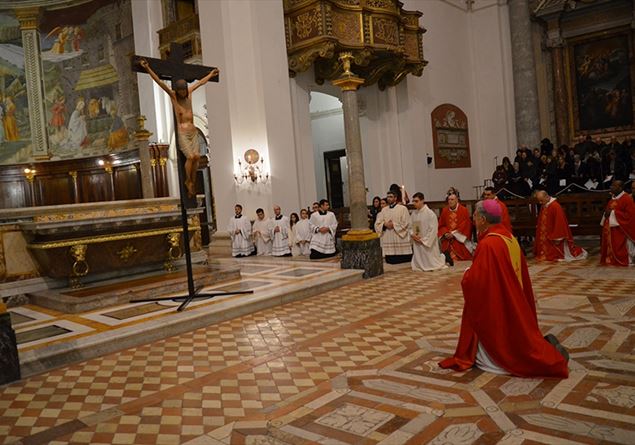The Good Friday It is the day in which the crucifixion and death of Jesus is celebrated. It is the second day of Easter triduum. On this day the Church does not celebrate the Eucharist but the liturgical action of the Lord’s passion, composed of the liturgy of the word, the adoration of the cross and the rites of communion.
It is a day of fasting and abstinence from meat.
The liturgical rites
On the morning of Good Friday, even if without solemnity, the Eucharistic adoration at the altar of the reposition is continued after the Thursday domains of Thursday. In many cathedral churches and also in several parishes, they are celebrated in community‘Reading office and morning praises.
On the afternoon of Good Friday the liturgical action of the Passion of the Lord takes place, called In passion domains, Which has very ancient origins (VII century), and is also present in the Byzantine rite, as one of the three types of divine liturgy.
This celebration is divided into three parts:
1. The liturgy of the word: First reading: fourth singing of the servant of the Lord (Isaiah 52,13-53,12) Second reading: the salvation of Christ through the painful obedience of passion (Jews 4.14-16; 5,7-9) Gospel: passion according to John (Jn 18.1-19.42) follows the solemn universal prayer.
2. The adoration of the Holy Cross.
3. The Communion With the Eucharistic species consecrated on Holy Thursday because on this day, the only one of the liturgical year, mass is not celebrated.
In the Ambrosian rite
Even the Ambrosian tradition, like the Roman one, commemorates the passion of the Lord of Holy Friday in a single afternoon or evening liturgy. There are two moments:
1. The celebration of the Lord’s passion. Characterized by three strong moments: the announcement of the death of the Lord. The Vesperina celebration of Holy Thursday commemorates the first act of the Lord’s passion while the Friday is the natural continuation as well as the fulfillment and finds its summit in the announcement of the death of Christ on the cross, with the reading of the passion according to Matteo from the point where he had been interrupted the previous evening (see Mt 27.1-56).
The adoration of the cross. The image of the Crucifix is brought solemnly on a pillow towards the main altar: three times the cross is raised, while the anti -theft “except Lignum Crucis in quo salus mundi pependit” is singing (“Here is the wood of the cross, to which the savior of the world was hung”) and three times everyone knelt in front of it in adoration. Again the cross, after being placed on the steps of the altar, is adored with three genuflections and with a kiss of veneration to the image of the crucifix. The universal prayer in which we pray solemnly for the needs of the Church and the world.
2. The Vespertin celebration “in the deposition of the Lord”. It focuses on Matteo’s evangelical pericope 27.57-61. The announcement of the death of the Lord, the adoration of the Holy Cross and the great universal prayer, create a strong ritual continuity between the profession of faith of the Roman centurion (cf. Mt 27.54) and the adoration of the faithful. In addition, two very significant passages of the proclamation of the word deserve to be highlighted: the first and second reading of the beginning of the Vespers, Is 49,24-50.10 and Is 52,13-53.12, as prophetic demands of the passion of Jesus.
In the Ambrosian tradition, Holy Friday, as well as all Fridays of Lent, is the daytime day, that is, the mass is not celebrated and the Eucharist is not distributed.
The tradition of the Via Crucis and the processions
Usually in each parish, in evening hours, the Via Crucis. Since 1965 the Pope has lived it in the suggestive setting of the Colosseum (click here to know its history).
In various Italian regions, imposing processions (suspended this year due to pandemic) with the crucifix, with the statues of the dead Christ and the Our Lady of Sorrows, or with the statues representing the stations of the Via Crucis, take place.
The silence of the bells as a sign of mourning
On Good Friday the bells do not play:
-In the Roman rite they play for the last time on the evening of Holy Thursday and precisely at the song of the Glory Duranta Mass in the Lord’s dinner, and then return to play during the Easter Vigil, always to the singing of glory, as a sign of the announcement of the Lord’s resurrection.
-In the Ambrosian rite The bells sound until the announcement of the death of the Lord, that is, until 3 pm on Good Friday, after which they silence the Easter vigil.


